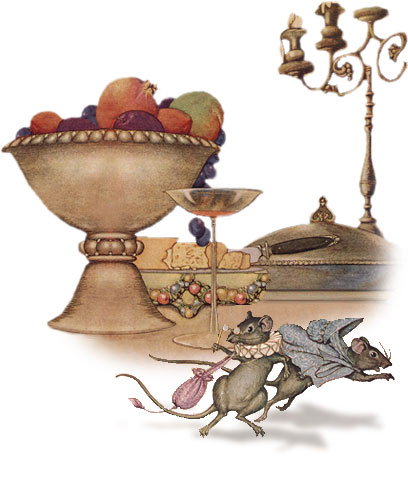The Town Mouse and the Country Mouse 城市老鼠和乡村老鼠 (精美插图) 双语 拼音注音 伊索寓言
标签:伊索寓言 儿童故事集 中英对照翻译 双语故事 拼音注音
Last Update 最后更新: 2022-01-12

The Town Mouse and the Country Mouse (English)
Total Words: 351
A Town Mouse once visited a relative who lived in the country. For lunch the Country Mouse served wheat stalks, roots, and acorns, with a dash of cold water for drink. The Town Mouse ate very sparingly, nibbling a little of this and a little of that, and by her manner making it very plain that she ate the simple food only to be polite.
After the meal the friends had a long talk, or rather the Town Mouse talked about her life in the city while the Country Mouse listened. They then went to bed in a cozy nest in the hedgerow and slept in quiet and comfort until morning. In her sleep the Country Mouse dreamed she was a Town Mouse with all the luxuries and delights of city life that her friend had described for her. So the next day when the Town Mouse asked the Country Mouse to go home with her to the city, she gladly said yes.
When they reached the mansion in which the Town Mouse lived, they found on the table in the dining room the leavings of a very fine banquet. There were sweetmeats and jellies, pastries, delicious cheeses, indeed, the most tempting foods that a Mouse can imagine. But just as the Country Mouse was about to nibble a dainty bit of pastry, she heard a Cat mew loudly and scratch at the door. In great fear the Mice scurried to a hiding place, where they lay quite still for a long time, hardly daring to breathe. When at last they ventured back to the feast, the door opened suddenly and in came the servants to clear the table, followed by the House Dog.
The Country Mouse stopped in the Town Mouse's den only long enough to pick up her carpet bag and umbrella.
"You may have luxuries and dainties that I have not," she said as she hurried away, "but I prefer my plain food and simple life in the country with the peace and security that go with it."
Moral: Poverty with security is better than plenty in the midst of fear and uncertainty.
城市老鼠和乡村老鼠 (中文翻译 拼音注音)
城市老鼠曾经拜访过住在乡下的亲戚。午餐时,乡下老鼠提供小麦秸秆、植物的根和橡子,还有少许冷水饮用。城市老鼠吃得很少,一点点这个,一点那个,从她的举止看,她吃简单的食物只是为了礼貌。
饭后朋友们聊了很久,或者说城市老鼠讲她在城里的生活,乡下老鼠听着。然后他们在树篱中舒适的窝里睡觉,安静而舒适地睡到早上。睡梦中,乡下老鼠梦见自己是一只城市老鼠,拥有她朋友为她描述的城市生活的所有奢华和乐趣。所以第二天,当城市老鼠让乡下老鼠和她一起回城时,她很高兴地答应了。
当他们到达城里老鼠住的宅邸时,他们发现餐厅的桌子上摆着一场盛大的宴会。有甜食和果冻、糕点、美味的奶酪,确实是老鼠能想象到的最诱人的食物。但就在乡下老鼠正要啃一块美味的糕点时,她听到一只猫在门上大声喵喵叫。老鼠们害怕极了,赶紧跑到一个藏身之处,在那里静静地躺了很长时间,几乎不敢呼吸。当他们终于冒险回到宴会上时,门突然打开,仆人进来清理桌子,家犬紧随其后。
乡下老鼠在城市老鼠的窝里停下来,只够装下她的手提包和雨伞。
“你可能有我没有的奢侈品和美食,”她匆匆离开时说,“但我更喜欢在乡下的简朴食物和简朴生活,以及随之而来的和平与安全。”
Relevant Fables 相关寓言故事
- 伊索寓言:The Lion and the Mouse 狮子和老鼠
- 伊索寓言:The Frog and the Mouse 青蛙和老鼠
- 伊索寓言:The Rat and the Elephant 老鼠和大象
- 伊索寓言:The Mice and the Weasels 老鼠和黄鼠狼
- 伊索寓言:The Cat the Cock and the Young Mouse 猫、公鸡和小老鼠
- 伊索寓言:The Mouse and the Weasel 老鼠和鼬
- 伊索寓言:The Cat and the Old Rat 猫和年迈的老鼠
About 关于
The Aesop Fables for Children 伊索寓言儿童故事全集 (图文英汉双语版) (this work), the english fables originally from The Aesop for Children: with Pictures by Milo Winter published by Rand, McNally & Co in 1919. Some of pictures come from Library of Congress. This work is considered to be in the public domain in the United States. The Aesop Fables for Children contains the text of selected fables, color pictures, video, and interactive animations, and will be enjoyed by readers of any age.
The Aesop Fables for Children are a collection of stories designed to teach moral lessons credited to Aesop, a Greek slave and story-teller thought to have lived between 620 and 560 BCE.
Aesop's fables are some of the most well known in the world and have been translated in multiple languages and become popular in dozens of cultures through the course of five centuries. They have been told and retold in a variety of media, from oral tradition to written storybooks to stage, film and animated cartoon versions—even in architecture. This page include translation to Simplified Chinese.
伊索寓言是一部世界上最早的寓言故事集,是世界文学史上流传最广的寓言故事之一。 本文包含伊索寓言故事英文原文和简体中文翻译(中英双语)。




